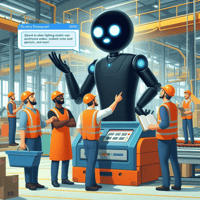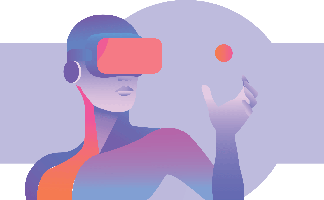Virtual assistants are AI software agents that assist computer systems by responding to requests...
The Economic Potential of Generative AI Innovation
Generative AI has witnessed significant advancements, becoming a powerful tool with transformative potential across all sectors and industries. According to McKinsey, it is estimated that generative AI could add up to $4.4 trillion in value to the global economy annually, impacting it by 15% to 40%. Its applications span various industries, such as healthcare, where it enhances disease diagnosis and treatment through data analysis and pattern identification. In the entertainment and retail sectors, it offers personalized experiences and improves customer interaction, respectively. Nevertheless, generative AI also poses challenges like job displacement and income inequality, emphasizing the need for careful consideration of its implementation.
Current State of Generative AI in the Global Economy
Generative AI has made remarkable strides in recent years, emerging as a powerful force capable of transforming industries worldwide. The impact of generative AI is widely recognized, with potential to generate substantial economic value. Its advancements have opened up a wide range of possibilities for businesses and organizations across sectors. This section explores the current state of generative AI in the global economy, shedding light on its advances and the potential economic benefits it brings.
Advances and Impact of Generative AI
Generative AI has advanced rapidly, showcasing its ability to create, design, and generate content autonomously. Its impact extends beyond automation, revolutionizing the way tasks are accomplished and paving the way for innovation. By analyzing vast amounts of data and identifying patterns and trends, generative AI enables businesses to make data-driven decisions with increased precision. The transformative potential of generative AI has the capacity to reshape industries, offering opportunities for growth and efficiency.
Potential Economic Benefits
- Productivity Boost: Generative AI has the potential to significantly enhance productivity by automating mundane and repetitive tasks, allowing human resources to focus on high-value activities.
- Cost Efficiency: The implementation of generative AI technologies can streamline business operations, reducing costs associated with labor and improving overall efficiency.
- Innovation Catalyst: By leveraging generative AI, businesses can unlock innovative solutions that were previously unattainable, generating new revenue streams and propelling economic growth.
- Competitive Advantage: Organizations that harness the power of generative AI stand to gain a competitive edge in the global market, as they can deliver products and services with enhanced quality and personalization.
The potential economic benefits of generative AI are substantial and far-reaching, with the capacity to drive growth, efficiency, and innovation across various industries. However, it is essential to carefully navigate the challenges and implications that arise with the adoption of this transformative technology.
Applications of Generative AI in Various Industries
The potential applications of Generative AI are vast across different industries, promising to revolutionize how we approach healthcare, entertainment, and retail sectors.
Health Sector: Improving Diagnosis and Treatment
In the healthcare industry, Generative AI is set to enhance the accuracy and efficiency of disease diagnosis and treatment. By analyzing large datasets and identifying patterns and trends, Generative AI can help healthcare professionals make more informed decisions. It has the capability to process complex medical imaging data, aiding in early detection of diseases and providing personalized treatment plans. Additionally, Generative AI can assist in drug development, accelerating the discovery of new therapies and improving patient outcomes.
Entertainment Industry: Personalized Experiences
The entertainment industry can leverage Generative AI to provide personalized and immersive experiences for consumers. Through data analysis of user preferences, Generative AI algorithms can generate tailored content such as movies, music playlists, or virtual reality experiences. By understanding individual preferences and behavior, entertainment platforms can deliver more engaging content, enhancing user satisfaction and loyalty.
Retail Sector: Enhanced Customer Interaction and Shopping Experience
In the retail sector, Generative AI offers opportunities for improved customer interaction and shopping experiences. Chatbots and virtual assistants powered by AI can engage with customers, provide product recommendations, and answer inquiries in real-time. Generative AI algorithms can also analyze customer behavior and preferences to offer personalized product suggestions, improving conversion rates and customer satisfaction. Additionally, AI can optimize inventory management, forecasting demand patterns and reducing waste.
These are just a few examples of how Generative AI can drive innovation and transformation across various industries. As technology continues to advance, the potential for harnessing Generative AI's capabilities will only grow, impacting the economy and society at large.
Advantages and Challenges of Generative AI
Generative AI presents several advantages and challenges in its implementation. This section examines the increased productivity and efficiency it offers, as well as the potential job displacement and income inequality it may cause.
Increased Productivity and Efficiency
One of the key advantages of generative AI is its ability to enhance productivity and efficiency across various industries. By automating certain tasks and processes, generative AI reduces the need for human labor and improves overall performance.
Through the analysis of large amounts of data and the identification of patterns and trends, generative AI can streamline decision-making processes. This not only saves time and resources but also enables organizations to make more informed and effective choices.
In addition, generative AI enables faster and more accurate data analysis, allowing businesses to gain valuable insights and identify opportunities for innovation. By leveraging advanced algorithms and machine learning techniques, generative AI can process and interpret data at a speed and scale that surpasses human capability.
Job Displacement and Income Inequality
Despite the numerous advantages, the widespread implementation of generative AI also raises concerns about job displacement and income inequality. As generative AI takes over certain tasks, there is a risk of job loss for workers who may no longer be needed in traditional roles.
This displacement of jobs can have significant economic and social implications. The disrupted labor market may struggle to reabsorb displaced workers, leading to unemployment and income disparities. It is crucial to address this challenge by investing in retraining and upskilling programs to ensure workers can adapt to the changing job market.
Furthermore, income inequality may widen as those with the necessary skills to work in conjunction with generative AI technologies might benefit from increased productivity, while others without such skills may struggle to find employment opportunities or experience reduced wages.
Addressing the potential challenges of job displacement and income inequality requires a proactive approach. Governments, organizations, and educational institutions must collaborate to provide opportunities for reskilling and education, ensuring that individuals have the skills and knowledge needed to participate in the evolving workforce.
- Promote retraining and upskilling programs
- Foster inclusive economic policies
- Invest in educational institutions and vocational training
- Encourage collaboration between industries and government entities
The Future of Generative AI and Its Potential Impact
Potential Growth in Global Economy:
Generative AI is expected to play a significant role in driving economic growth at a global level. With its ability to automate tasks, analyze large datasets, and generate valuable insights, generative AI has the potential to contribute to economic expansion across various sectors. This growth is anticipated to be fueled by increased productivity, improved decision-making processes, and the fostering of innovation.
Decision Making and Innovation:
One of the key aspects of the future impact of generative AI lies in its ability to enhance decision making and foster innovation. By analyzing extensive amounts of data and identifying patterns, generative AI algorithms can provide valuable insights to assist decision makers in making informed choices. Furthermore, by automating certain processes, generative AI frees up human resources to focus on more strategic and creative endeavors, which can drive innovation and push boundaries across industries. This convergence of technology and human ingenuity has the potential to transform industries and fuel economic growth.
Socioeconomic Implications:
While the future of generative AI holds great promise, it is essential to consider the socioeconomic implications that come with its widespread adoption. As automation and artificial intelligence become more prevalent, job displacement and income inequality may arise. It is important to ensure that as generative AI evolves, measures are put in place to support individuals affected by these changes. By investing in education and retraining programs, governments can help workers adapt to the evolving job market and seize new opportunities that arise from the advancements in generative AI. This proactive approach can mitigate potential negative consequences and create a more inclusive and prosperous future for all.
- Generative AI has the potential to drive economic growth globally.
- By automating tasks and analyzing data, generative AI can contribute to increased productivity.
- The technology's ability to generate valuable insights can enhance decision making and drive innovation.
- However, careful consideration must be given to the socioeconomic implications, such as job displacement and income inequality.
- Investments in education and retraining programs can help individuals adapt to the changing job market.
.png)





Leave your comment